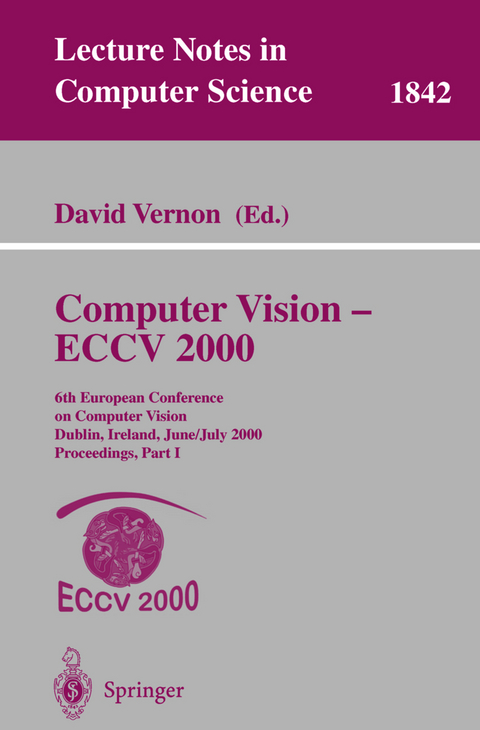Computer Vision - ECCV 2000
Springer Berlin (Verlag)
978-3-540-67685-0 (ISBN)
Recognition & Modelling I.- Non-linear Bayesian Image Modelling.- Unsupervised Learning of Models for Recognition.- Learning over Multiple Temporal Scales in Image Databases.- Colour Image Retrieval and Object Recognition Using the Multimodal Neighbourhood Signature.- Stereoscopic Vision.- Approximate N-View Stereo.- A Minimal Set of Constraints for the Trifocal Tensor.- Intrinsic Images for Dense Stereo Matching with Occlusions.- Recognition & Modelling / Stereoscopic Vision / Texture, Shading, & Colour.- Local Scale Selection for Gaussian Based Description Techniques.- Anti-Faces for Detection.- Combining Elastic and Statistical Models of Appearance Variation.- Object Recognition Using Coloured Receptive Fields.- Learning Similarity for Texture Image Retrieval.- Parametric View-Synthesis.- Least Committment Graph Matching by Evolutionary Optimisation.- Predicting Disparity Windows for Real-Time Stereo.- On the Estimation of the Fundamental Matrix: A Convex Approach to Constrained Least-Squares.- Velocity-Guided Tracking of Deformable Contours in Three Dimensional Space.- Model Based Pose Estimator Using Linear-Programming.- Measuring the Self-Consistency of Stereo Algorithms.- Log-Polar Stereo for Anthropomorphic Robots.- Contour-Based Correspondence for Stereo.- Color and Scale: The Spatial Structure of Color Images.- Constrained Dichromatic Colour Constancy.- Objective Colour from Multispectral Imaging.- Colour by Correlation in a Three-Dimensional Colour Space.- Improvements to Gamut Mapping Colour Constancy Algorithms.- Gray Scale and Rotation Invariant Texture Classification with Local Binary Patterns.- Adapting Spectral Scale for Shape from Texture.- Recognition & Modelling II.- Learning to Recognize 3D Objects with SNoW.- Region-Based Object Recognition Using Shape-from-Shading.- Recognizing Walking People.- A Probabilistic Sensor for the Perception and the Recognition of Activities.- Structure from Motion I.- Homography Tensors: On Algebraic Entities ThatRepresent Three Views of Static or Moving Planar Points.- Plane + Parallax, Tensors and Factorization.- Factorization with Uncertainty.- Estimating the Jacobian of the Singular Value Decomposition: Theory and Applications.- Shape.- Diffeomorphic Matching Problems in One Dimension: Designing and Minimizing Matching Functionals.- Level Sets and Distance Functions.- Divergence-Based Medial Surfaces.- Structure from Motion / Shape / Image Features.- 3D Reconstruction from Tangent-of-Sight Measurements of a Moving Object Seen from a Moving Camera.- A Six Point Solution for Structure and Motion.- Reconstruction from Uncalibrated Sequences with a Hierarchy of Trifocal Tensors.- Characterizing Depth Distortion Due to Calibration Uncertainty.- On Calibration and Reconstruction from Planar Curves.- How Does CONDENSATION Behave with a Finite Number of Samples?.- On the Structure and Properties of the Quadrifocal Tensor.- Geotensity Constraint for 3D Surface Reconstruction under Multiple Light Sources.- Noise-Resistant Affine Skeletons of Planar Curves.- Shape and Radiance Estimation from the Information Divergence of Blurred Images.- Surface Matching with Large Deformations and Arbitrary Topology: A Geodesic Distance Evolution Scheme on a 3-Manifold.- Duals, Invariants, and the Recognition of Smooth Objects from Their Occluding Contour.- On Utilising Template and Feature-based Correspondence in Multi-view Appearance Models.- Wide Baseline Point Matching Using Affine Invariants Computed from Intensity Profiles.- Determining Correspondences for Statistical Models of Appearance.- Approximation and Processing of Intensity Images with Discontinuity-Preserving Adaptive Triangular Meshes.- Scale Dependent Differential Geometry for the Measurement of Center Line and Diameter in 3D Curvilinear Structures.- Fast Selective Detection of Rotational Symmetries Using Normalized Inhibition.- Structure from Motion II.- Multibody Structure and Motion: 3-D Reconstruction of Independently MovingObjects.- Integrating Local Affine into Global Projective Images in the Joint Image Space.- Ambiguous Configurations for 3-View Projective Reconstruction.- On the Reprojection of 3D and 2D Scenes without Explicit Model Selection.
| Erscheint lt. Verlag | 19.6.2000 |
|---|---|
| Reihe/Serie | Lecture Notes in Computer Science |
| Zusatzinfo | XXXVI, 955 p. |
| Verlagsort | Berlin |
| Sprache | englisch |
| Maße | 155 x 235 mm |
| Gewicht | 1210 g |
| Themenwelt | Informatik ► Grafik / Design ► Digitale Bildverarbeitung |
| Schlagworte | 3-D Vision • computer vision • Hardcover, Softcover / Informatik, EDV/Informatik • HC/Informatik, EDV/Informatik • Image Processing • Maschinelles Sehen • Object recognition • pattern recognition • robot • robot systems • Robot vision • Shading • Stereo • vision systems • visual motion • visual perception |
| ISBN-10 | 3-540-67685-6 / 3540676856 |
| ISBN-13 | 978-3-540-67685-0 / 9783540676850 |
| Zustand | Neuware |
| Haben Sie eine Frage zum Produkt? |
aus dem Bereich




